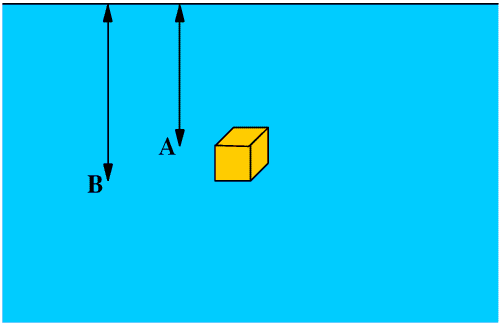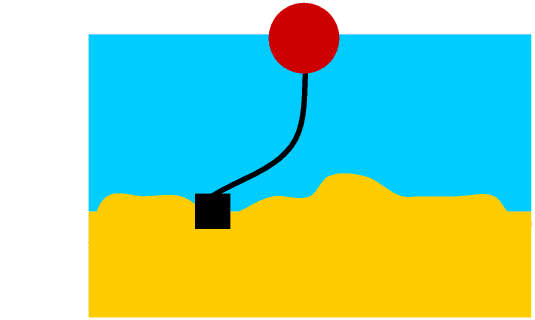
When a diver goes down into the sea, the deeper he goes the greater the weight of water above him and so the greater the water pressure on him. This pressure acts in every direction on his body, upwards, downwards and sideways.
If we immerse a solid cube in water the bottom of the cube is deeper under water than the top, so the water pressure on the bottom is greater than that on the top. There will therefore be an upward force on the cube. This upward force is called buoyancy. It does not matter what the cube is made of, but if the cube's buoyancy is greater than its weight it will try to float to the top and if its buoyancy is less than its weight it will try to sink to the bottom.
Of course, the water pressure also produces a force on the sides of the cube but because the water pressure acts in every direction the total force on the left hand side of the cube is equal to that on the right hand side (and the same for the front and back) so there is no net sideways force.

The difference in pressure between Point A, level with the top of the cube, and Point B, level with the bottom of the cube, is due only to the difference in the weight of water above Point A and that above Point B, so we can show that the buoyancy of the cube is equal to the weight of water that would have the same volume as the cube. This is usually known as Archimedes' Principle. Archimedes' Principle states that
When a body is wholly or partially immersed in a fluid it experiences an upthrust equal to the weight of fluid displaced.It is true for all liquids and gases but for most of the rest of this Page we shall consider only buoyance in water and air. It is also true whatever the shape of the body and whether it is fully or partially immersed in the fluid.
Archimedes was one of the greatest scientists of all time. He also did some work on density and people often confuse this work with his work on buoyancy but they are quite different. You can read about his work on density here.

You will need a bucket or bowl or bath of water, a metal weight, a piece of wood, some string and a balloon. Ask permission first.
Tie a piece of string round the metal weight and lower it slowly into the water. As you do so you should feel the weight getting lighter, although it is easier to feel the opposite effect as you slowly raise the weight out of the water. (Don't forget to dry the weight before you put it away.)
Now do the same with the wood.
Finally blow up the balloon and try to push it under the water. If you are using a bowl or bucket rather than a bath do this out of doors. Otherwise you will find out what Archimedes found out.... the hard way!
If you have a spring balance, for example an angler's balance, you can actually measure the buoyancy by hanging the weight from the balance and seeing how the reading changes as you lower the weight into the water, but remember that buoyancy is a force so should correctly be measured in newtons.

A human body is usually about 95% of the density of water and so will normally float with about 5% of it above the surface. The chest however is largely empty because it contains the lungs, so unfortunately the stable position for the body to float is with the upper back just breaking the surface and the head, arms and legs hanging down.


© Barry Gray November 2009 revised March 2013